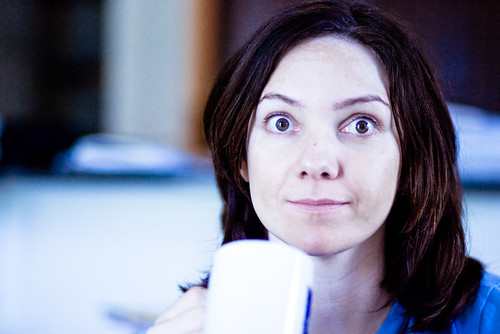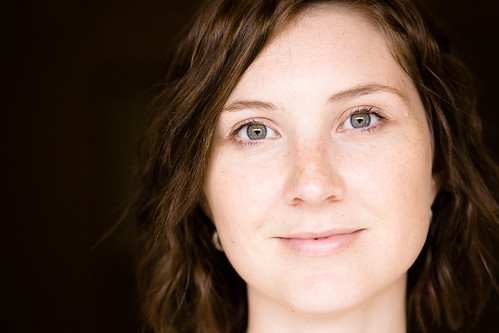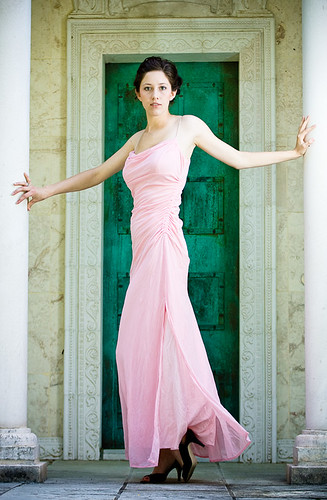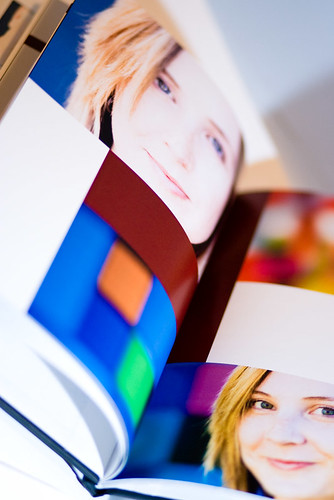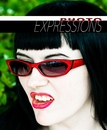Thursday, May 29, 2008
A couple of things to read or listen to. Craig Tanner has updated his Myth of Talent talk and now much more strongly emphasises the need for a strong belief as motivation to developing talent. A lot of this seems to come down to visualising an expected outcome, then moving towards it. Listening to Craig's podcast brought me back to my own experience and how transforming the Next Step workshop proved to be, personally. Emotionally difficult, painful at times but it made a dramatic change to my approach to photography and life in general. Not as life-threatening or dramatic as Craig's own example but I can relate to the shift in belief and world view that he talks about and how it can change your outlook.
The discussion on experts at the start of the podcast seems to lean heavily towards the concepts of thin slicing that are discussed in Malcolm Galdwell's book, Blink (The Power of Thinking Without Thinking). The idea that after much training, our unconscious mind can start making the decisions behind the scenes, enabling creativity and intuition, all via the mechanism of learned response and experience. As a result, you have whatever artistic gift or photographic experience that you have as a starting point, but conscious practice, hard work and repeated exposure to ideas and imagery will inform your future work, to a point where it becomes automatic and innate. It just takes hard work and lots of it. You need the passion to drive the hard work and the belief to keep going, but you can get there.
The second, related piece is by Neil Gaiman on the ways to find a personal style. Neil is talking about writing style but I think it applies generally. The interesting question is about half way through this blog post, when someone asks how to stop copying other authors when they write; to avoid those influences and develop their own style. The simple answer is You write more or for us, you take more photographs. Eventually, style becomes what you can't help doing. It arrives after long enough practice - I think in part because of the ideas I mentioned earlier - thin slicing and intuition inform your style. It becomes how you see, or how you write or how you take pictures. The bottom line to Neil's post is something I've found myself and mentioned before. Honesty is what style is all about. Being true to your own interests or vision. Taking and sharing the pictures you want to take, not the things you think other people would be interested in. Make the pictures for yourself in a way that you like. Then you'll find your own style. Look inwards for the validation and enjoyment. Maybe other people will like the images, maybe they wont, but you'll have a lot more fun and satisfaction if you honestly follow your own creativity.
Thursday, May 22, 2008
dancing about architecture
Listened to an interesting discussion this evening from Jeff Curto, on his Camera Position podcast/blog. Jeff was describing what he considered the contribution of an arts background was to a photographer. I have had a very engineering focused education, with very little exposure to the arts. I've always felt somewhat limited as a result of that, particularly when I venture into what might be considered fine art photography. Often I just don't have the context to even understand work or to talk about it in a sensible way. I don't mean the obfuscated, cliche-ridden world of 'artspeak' but just to be able to find the intersections and shared ideas that can really bring work to life.
I often hear people discuss symbolism and archetypes in work and I'm groping towards what that really means and how to use it. Pictures that aren't what the subject is, but what else it is. Matters of colour theory or clever nods and winks back to other work. I've looked at a lot of photography but maybe haven't ventured far enough afield into other areas or types of artistic expression to really get the breadth or depth of knowledge that I'd like to have.
Jeff talks about the purpose of an arts background really being about exposure to a lot of ideas and art. Perhaps it could be considered as a guided, focused tour through the history of artistic styles. The study gives you the opportunity to synthesize ideas together in your head. To make connections, to spawn new ideas and perhaps avenues for your own photographic work.
To me that is quite a marked contrast to the much more teaching-oriented engineering discipline. There are right and wrong answers, much of the learning is understanding methods and mathematical approaches. Certainly at a deeper level it is also about exposure to and synthesis of ideas and concepts , but there seems to be something different going on with the arts approach. Knowing and experiencing is perhaps more important and there aren't right answers, just ideas.
Jeff also touches on another subject that I've kept coming back to in this blog. That's the idea of shooting things that you care about. Finding the things that you love or that you are passionate about and making pictures on, around or about those topics. That seems to be the best way to push deeply enough into an area to have the opportunity to do interesting work. On the flip side, I'm also keenly interested in photographing the things that scare me a bit or that I'm afraid of. Following your fears as well as your passions seems to be a powerful way to make good progress. Really I think that passion and fear are both parts of the same idea of following your strong emotional responses and trying to bring that into your images.
I've seen a big improvement in my pictures when I do this and also changes in my own life that reach out into other parts, helping with more than just image making. An upcoming work event will require quite a lot of networking and generally approaching strangers, making a quick impression, talking, making conversation. Used to be that was a particular area that I was uncomfortable with, but the last year or two of portrait photography has helped me develop just those skills. What was a bit of a concern now doesn't really bother me at all.
Jeff's discussion can be heard here and there is a follow-up discussion on his blog. Get involved if it interests you.
Posted by
Unknown
at
9:52 PM
2
comments
![]()
Labels: backgrounds, barriers, progress
Thursday, May 15, 2008
there and back again
Paul asked some good questions about the SoFoBoMo experience.
Was it fun?
Stressful, stretching, gut squirmingly worrying but fun all the same. That sort of deep fun that comes from the satisfaction of a job well done, rather than the superficial fun that arrives more passively.
What sort of things did you learn?
What a book looks like. Recognising the structure, with two title pages at the start of every photography book I own surprised me. I learned an amazing amount about fonts and typography in a very short space of time. I know now about em dashes and other twiddly bits that I'd never even noticed before. My eyes have become a bit more tuned into features in a book that I never knew existed. As is typical with this sort of revelation, I can't stop seeing them in everything I read for just now. Also picked up a lot of fundamentals of graphic design which have been useful in other aspects of my life.
I managed to re-enforce my understanding that most people, including complete strangers, will happily let you take their picture and often be very flattered that you asked. Having the story of 'doing a book' didn't really help or hinder - everyone was very kind and helpful.
I learned a lot about how Adobe InDesign works and found it pretty easy to use. The PDF generation and layout were relatively easy, the main distraction was the lack of features for soft proofing for RGB print output, it all being tuned towards CMYK separations. Doing a proof book with blurb prior to the whole SoFoBoMo exercise really helped me understand the quirks of Print On Demand, which is maybe why I've had less problems than others with Blurb and similar companies.
I got to fiddle with Yahoo pipes and play with their GUI scripting tools. While neat, it further convinced me of the horrors and general pain of using a GUI to write code. Things that should have been simple and quick in a text editor drag on while I wait on forms to load and widgets to drag around the screen. Functional, fun for everyone involved but a pain to update and maintain. Give me a text file and vim over a GUI web editor any day of the week.
I learned I'm still not very good at soft proofing. That seems to be mostly experience and will come with time, I'm sure. I just don't do enough print output to be able to interpret well what I say on the screen and how it'll translate to a sheet of paper.
Was your experience pretty much what you expected, or it did turn out that doing the book was wildly different from what you'd pictured when you signed up?
It was a lot more work than I expected, given how little I really produced (400+ pictures, but not much text or complexity in the layout). I was particularly surprised by how much Holly managed to find wrong with my typography, for just 4 simple pages of text, that had been carefully proof read and spell checked by that point. I have a satisfyingly smug feeling about getting it done within the alloted time and am actually looking forward to working on my next book soon. Overall it was pretty much what I expected coming in, but I've been through the process a couple of times with much simpler and simpler looking books. The act of writing was as fun and painful as ever. I enjoy writing but my mind twists and turns and tries to avoid it at every opportunity. Blogging in general is helping with that, but I'm always in an on-going battle with myself to actually sit down and put words on a page. The more I do it the easier it gets, so I just need to get on with it I suppose.
What aspects of the whole thing were frustrating?
I can't think of any aspect that was frustrating. It was stressful for a while trying to shoot enough good portraits for the book. I suppose I am frustrated by a few potentially great images that I lost of stupidity - incorrect camera settings, not catching that the shutter speed was too slow at the time of shooting, that sort of thing. That's just my on-going occasional frustration with photography, not something SoFoBoMo specific.
What aspects were most rewarding?
Seeing all the finished books on the sofobomo.org project page. (32 so far!). Opening the box and pulling out the finished copy of my book is a close second. Over 4400 views/hits on my Issuu version of the book is quite rewarding too.
Having participated this year (regardless of whether you finished it or not), would you ever want to do it again?
Yes, certainly. I am surprised by the creative vacuum left behind by doing this one project. I'm sure that will go away soon. Probably true from any really intense period of effort.
Do you have suggestions about ways to change things to make it more successful/fun/educational/rewarding for participants in future SoFoBoMo events?
I'm not sure what could be more fun and rewarding than having a book! with my name on it! that I made! We could no doubt capture our experiences this year and bottle them up, to present as a how to make a book course, but part of the endeavor and value for me was not having an easy, predefined path to follow. Making it up as I went along and making the decisions an mistakes were part and parcel of what I learned and valued from the process. I think if someone came up with a 35 photo page template generator that I just pointed at a set of images and a PDF book fell out the other end, it would be a much reduced experience, for example. SoFoBoMo is a great dangling carrot to place in front of people. The challenge is well defined, the goal is reachable with a stretch and easy to understand. I don't think it could be presented much better.
From my perspective, maybe because I'm a photographer and not a writer, it seems like an easier goal than the 50,000 word bar for the National Novel in a Month challenge, or 12 songs for the album in a month. Maybe next time around we try to raise the bar a bit. Not sure about that for now or what form it would take. Perhaps we just have to raise our own personal bar, rather than dragging everyone kicking and screaming with us. Many people have taken up the additional challenge to try to produce a PoD physical book from their SoFoBoMo PDF. That seems like a good example of that sort of bar raising. Not sure what the next step is - trying to produce a publishable book in a month and then re-editing and re-working it and taking it to publishers? I know I certainly didn't have that aim this time around.
What resources did you find helpful?
The Non-Designer’s Type Book, Second Edition and
The Non-Designer's Design Book, Third Edition both by Robin Williams
I found several good blogs about PoD and blurb/InDesign that were helpful. More specifically SoFoBoMo related, I found a large collection of photography books useful to see what a book really looks like. The community of bloggers that sprung up around SoFoBoMo and the yahoo pipe I put together really helped me feel connected to the rest of the people struggling along at the same time. I think that connection and shared experience was one of the most valuable and helpful aspects of this first attempt. Motivated me at times when I might have just quit because things were too time consuming or hard.
What aspects of SoFoBoMo were positive surprises? What aspects were disappointments?
I was surprised by just how many people seemed excited by the idea and got involved, both personally, wanting to see the book, being supportive, and actually creating their own SoFoBoMo books or even just attempting what is still a big goal. I thought there would be a dozen at most. Getting to write a promo piece for the Online Photographer was fun, mainly to see the effect on my page hits. I am curious to know if we got any new participants from that, or if it was a bit too late in the fuzzy month to get on board.
 How about that fuzzy month thing? Did that work for you, or not?
Worked well, though I suppose I cheated and jumped the gun by a few days. I was surprised to actually finish the PDF in only 3 weeks from start to finish. I do think that the late starters might be missing out a bit on the shared experience now that some of us early bolters are finished. Maybe a shorter fuzzy window would help (I saw Eric suggested 6 weeks in the discussion on Paul's blog - that might not be a bad limit to try)
How about that fuzzy month thing? Did that work for you, or not?
Worked well, though I suppose I cheated and jumped the gun by a few days. I was surprised to actually finish the PDF in only 3 weeks from start to finish. I do think that the late starters might be missing out a bit on the shared experience now that some of us early bolters are finished. Maybe a shorter fuzzy window would help (I saw Eric suggested 6 weeks in the discussion on Paul's blog - that might not be a bad limit to try)
 How about that fuzzy month thing? Did that work for you, or not?
Worked well, though I suppose I cheated and jumped the gun by a few days. I was surprised to actually finish the PDF in only 3 weeks from start to finish. I do think that the late starters might be missing out a bit on the shared experience now that some of us early bolters are finished. Maybe a shorter fuzzy window would help (I saw Eric suggested 6 weeks in the discussion on Paul's blog - that might not be a bad limit to try)
How about that fuzzy month thing? Did that work for you, or not?
Worked well, though I suppose I cheated and jumped the gun by a few days. I was surprised to actually finish the PDF in only 3 weeks from start to finish. I do think that the late starters might be missing out a bit on the shared experience now that some of us early bolters are finished. Maybe a shorter fuzzy window would help (I saw Eric suggested 6 weeks in the discussion on Paul's blog - that might not be a bad limit to try)
Posted by
Unknown
at
7:58 AM
4
comments
![]()
Labels: sofobomo
Monday, May 12, 2008
strobist GTG at dunvegan keep
I'm still feeling the post-SoFoBoMo apathy but the rescheduled due to rain Strobist GTG was yesterday. I managed to drag myself along, planning just to catch up with some people and hold reflectors when needed.
It was a beautiful, sunny day in the mid-70s. Perfect weather to be outside but a bit challenging photographically, lots of dappled light and sun/shade. We'd also made the slight mis-step of rescheduling on Mother's Day so a lot of people had other things to do.
I did take a few pictures in the end and actually changed lenses, switching to the 70-200 F4L and trying to work on full body images, rather than just head shots. Maybe I'm starting to get some mojo back. For now, I just really enjoyed the lovely weather. For this shot of Rebekah, I was lying prone on the grass to get a low angle, shooting towards the longer end of the 200mm. I asked her to move and twist to get some motion in the dress and stop things being too static. The green door was a big part of setting up here and the doorway has a porch overhead that cut the direct sunlight.
Posted by
Unknown
at
8:02 AM
2
comments
![]()
Wednesday, May 07, 2008
SoFoBoMo where are you?
Based on the idea over on Sam's blog, please add yourself to the map if you've been in on the whole SoFoBoMo experience. You can also link to the map with this url : http://www.frappr.com/sofobomo
Posted by
Unknown
at
7:14 AM
3
comments
![]()
Friday, May 02, 2008
sofobomo.org
The web site is up and people are sharing their finished books, over at
Posted by
Unknown
at
8:22 AM
2
comments
![]()
Subscribe to:
Posts (Atom)

